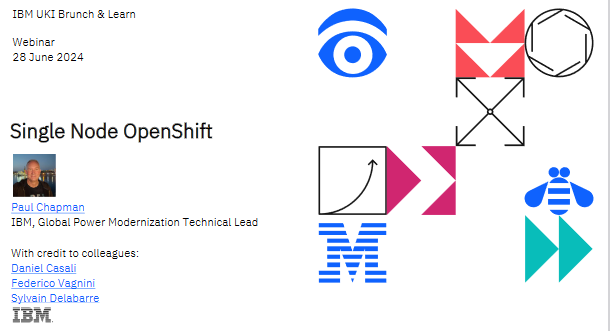At a recent UKI Brunch & Learn webinar, I shared valuable insights on Single Node OpenShift (SNO) – a streamlined version of Red Hat’s popular Kubernetes platform that packs all functionality into a single node. Below is a replay recording, a copy of the presentation and the key takeaways:
Webinar Replay
Presentation
What is Single Node OpenShift?
- SNO combines control plane and worker node functions into one machine
- Requires minimum 8 vCPUs (1 physical core on POWER), 16GB RAM, 120GB storage
- Generally available on x86 since OpenShift 4.9, on POWER since 4.14
- Fully supported by Red Hat, uses standard OpenShift subscriptions
Use Cases
- Edge computing deployments
- Retail/store environments
- Development and testing
- Demos and education
Key Benefits
- Reduced resource requirements vs. multi-node clusters
- Easier to deploy in resource-constrained environments
- Manageable via Red Hat Advanced Cluster Manager
Installation Methods
- Manual install using Red Hat documentation and custom scripts
- Ansible playbooks (credit to Federico Vagnini for creating these)
- Red Hat Assisted Installer GUI
- Helper node method (not covered in webinar)
Demonstrations
Paul demonstrates two live installations during the webinar:
- Manual script-based install
- Ansible playbook install
Both methods were completed in 30-45 minutes, resulting in fully functional OpenShift clusters.
Limitations to Consider
- No built-in high-availability
- Cannot expand to multi-node after install
- Limited to single architecture (no multi-arch support)
- For x86, production use requires bare metal (not supported on VMware)
Conclusion
The webinar highlighted SNO’s potential to bring OpenShift’s power to smaller deployments, making containerization more accessible for a wider range of use cases. As organizations look to modernize applications at the edge or in distributed environments, Single Node OpenShift offers a compelling option worth exploring.
For more details on installation methods and configuration, check out Paul’s scripts and the Ansible playbooks referenced in the webinar.

Leave a Reply